Screening of Potential Additives for Alleviating Slagging and Fouling during MSW Incineration: Thermodynamic Analysis and Experimental Evaluation
Abstract
:1. Introduction
2. Experimental Section
2.1. Thermodynamic Equilibrium Analysis
2.2. Screening of Potential Fouling Preventatives
2.3. Screening of Potential Additive for Enhancing the Combustion Reactivity of MSW Char
3. Results and Discussion
3.1. Effect of Incineration Temperature and Different Additives on the Migration and Transformation of Major Elements in Ash by Using Thermodynamic Equilibrium Analysis
3.1.1. Effect of Incineration Temperature on the Migration and Transformation of Major Elements in Ash by Using Thermodynamic Equilibrium Analysis
3.1.2. Effect of Al(NO3)3 Addition on the Migration and Transformation of Major Elements in Ash by Using Thermodynamic Equilibrium Analysis
3.1.3. Effect of Mg(NO3)2 Addition on the Migration and Transformation of Major Elements in Ash by Using Thermodynamic Equilibrium Analysis
3.1.4. Effect of Ca(NO3)2 Addition on the Migration and Transformation of Major Elements in Ash by Using Thermodynamic Equilibrium Analysis
3.1.5. Effect of Ba(NO3)2 Addition on the Migration and Transformation of Major Elements in Ash by Using Thermodynamic Equilibrium Analysis
3.1.6. Effect of NH4HPO4 Addition on the Migration and Transformation of Major Elements in Ash by Using Thermodynamic Equilibrium Analysis
3.1.7. Effect of Cu(NO3)2 Addition on the Migration and Transformation of Major Elements in Ash by Using Thermodynamic Equilibrium Analysis
3.1.8. Effect of KMnO4 Addition on the Migration and Transformation of Major Elements in Ash by Using Thermodynamic Equilibrium Analysis
3.2. Influence of the Potential Additives on the Ash Fusion Temperature
3.3. Effect of Potential Additives on the Combustion Reactivity of MSW Char
4. Conclusions
Author Contributions
Funding
Institutional Review Board Statement
Informed Consent Statement
Data Availability Statement
Acknowledgments
Conflicts of Interest
References
- Ding, Y.; Zhao, J.; Liu, J.-W.; Zhou, J.; Cheng, L.; Zhao, J.; Shao, Z.; Iris, Ç.; Pan, B.; Li, X. A review of China’s municipal solid waste (MSW) and comparison with international regions: Management and technologies in treatment and resource utilization. J. Clean. Prod. 2021, 293, 126144. [Google Scholar] [CrossRef]
- Guo, W.; Xi, B.; Huang, C.; Li, J.; Tang, Z.; Li, W.; Ma, C.; Wu, W. Solid waste management in China: Policy and driving factors in 2004–2019. Resour. Conserv. Recycl. 2021, 173, 105727. [Google Scholar] [CrossRef]
- Sharma, P.; Kumar, S. Characterization and phytotoxicity assessment of organic pollutants in old and fresh municipal solid wastes at open dump site: A case study. Environ. Technol. Innov. 2021, 24, 101938. [Google Scholar] [CrossRef]
- Lu, J.-W.; Zhang, S.; Hai, J.; Lei, M. Status and perspectives of municipal solid waste incineration in China: A comparison with developed regions. Waste Manag. 2017, 69, 170–186. [Google Scholar] [CrossRef] [PubMed]
- Wei, C.; Yu, Z.; Zhang, X.; Ma, X. Co-combustion behavior of municipal solid waste and food waste anaerobic digestates: Combustion performance, kinetics, optimization, and gaseous products. J. Environ. Chem. Eng. 2021, 9, 106028. [Google Scholar] [CrossRef]
- Cao, B.; Yuan, J.; Jiang, D.; Wang, S.; Barati, B.; Hu, Y.; Yuan, C.; Gong, X.; Wang, Q. Seaweed-derived biochar with multiple active sites as a heterogeneous catalyst for converting macroalgae into acid-free biooil containing abundant ester and sugar substances. Fuel 2021, 285, 119164. [Google Scholar] [CrossRef]
- Lachman, J.; Baláš, M.; Lisý, M.; Lisá, H.; Milčák, P.; Elbl, P. An overview of slagging and fouling indicators and their applicability to biomass fuels. Fuel Processing Technol. 2021, 217, 106804. [Google Scholar] [CrossRef]
- Zhong, D.; Zeng, K.; Li, J.; Qiu, Y.; Flamant, G.; Nzihou, A.; Vladimirovich, V.S.; Yang, H.; Chen, H. Characteristics and evolution of heavy components in bio-oil from the pyrolysis of cellulose, hemicellulose and lignin. Renew. Sustain. Energy Rev. 2022, 157, 111989. [Google Scholar] [CrossRef]
- Niu, Y.; Tan, H. Ash-related issues during biomass combustion: Alkali-induced slagging, silicate melt-induced slagging (ash fusion), agglomeration, corrosion, ash utilization, and related countermeasures. Prog. Energy Combust. Sci. 2016, 52, 1–61. [Google Scholar] [CrossRef]
- Alam, M.T.; Dai, B.; Wu, X.; Hoadley, A.; Zhang, L. A critical review of ash slagging mechanisms and viscosity measurement for low-rank coal and bio-slags. Front. Energy 2021, 15, 46–67. [Google Scholar] [CrossRef]
- Bryers, R.W. Fireside slagging, fouling, and high-temperature corrosion of heat-transfer surface due to impurities in steam-raising fuels. Prog. Energy Combust. Sci. 1996, 22, 29–120. [Google Scholar] [CrossRef]
- Sheng, C.; Li, Y.; Liu, X.; Yao, H.; Xu, M. Ash particle formation during O2/CO2 combustion of pulverized coals. Fuel Processing Technol. 2007, 88, 1021–1028. [Google Scholar] [CrossRef]
- Li, M.-J.; Tang, S.-Z.; Wang, F.-l.; Zhao, Q.-X.; Tao, W.-Q. Gas-side fouling, erosion and corrosion of heat exchangers for middle/low temperature waste heat utilization: A review on simulation and experiment. Appl. Therm. Eng. 2017, 126, 737–761. [Google Scholar] [CrossRef]
- Fan, Y.; Lyu, Q.; Zhu, Z.; Zhang, H. The impact of additives upon the slagging and fouling during Zhundong coal gasification. J. Energy Inst. 2020, 93, 1651–1665. [Google Scholar] [CrossRef]
- Roberts, L.J. Additives to Mitigate Against Slagging and Fouling in Biomass Combustion. Ph.D. Thesis, University of Leeds, Leeds, UK, 2018. [Google Scholar]
- Wang, L.; Hustad, J.E.; Skreiberg, Ø.; Skjevrak, G.; Grønli, M. A critical review on additives to reduce ash related operation problems in biomass combustion applications. Energy Procedia 2012, 20, 20–29. [Google Scholar] [CrossRef] [Green Version]
- Sowa, J.M.; Fletcher, T.H. Investigation of an iron-based additive on coal pyrolysis and char oxidation at high heating rates. Fuel Processing Technol. 2011, 92, 2211–2218. [Google Scholar] [CrossRef]
- Liu, Q.; Zhong, W.; Zhou, J.; Yu, Z. Effects of S and Al on K Migration and Transformation during Coal and Biomass Co-combustion. ACS Omega 2022, 7, 15880–15891. [Google Scholar] [CrossRef]
- Jun, Z.; Qian, L.I.U.; Zhong, W.-q.; Yu, Z.-w. Migration and transformation law of potassium in the combustion of biomass blended coal. J. Fuel Chem. Technol. 2020, 48, 929–936. [Google Scholar]
- Yang, W.; Pudasainee, D.; Gupta, R.; Li, W.; Wang, B.; Sun, L. An overview of inorganic particulate matter emission from coal/biomass/MSW combustion: Sampling and measurement, formation, distribution, inorganic composition and influencing factors. Fuel Processing Technol. 2021, 213, 106657. [Google Scholar] [CrossRef]
- Wei, X.; Schnell, U.; Hein, K.R.G. Behaviour of gaseous chlorine and alkali metals during biomass thermal utilisation. Fuel 2005, 84, 841–848. [Google Scholar] [CrossRef] [Green Version]
- Li, R.; Kai, X.; Yang, T.; Sun, Y.; He, Y.; Shen, S. Release and transformation of alkali metals during co-combustion of coal and sulfur-rich wheat straw. Energy Convers. Manag. 2014, 83, 197–202. [Google Scholar] [CrossRef]
- Liu, Y.; Cheng, L.; Zhao, Y.; Ji, J.; Wang, Q.; Luo, Z.; Bai, Y. Transformation behavior of alkali metals in high-alkali coals. Fuel Processing Technol. 2018, 169, 288–294. [Google Scholar] [CrossRef]
- de Oliveira, J.F.; Corazza, M.L.; Voll, F.A.P. Thermodynamic analysis of municipal solid waste gasification under isothermal and adiabatic conditions by a Gibbs free energy minimization model. Waste Biomass Valorization 2019, 10, 1383–1393. [Google Scholar] [CrossRef]
- Sreejith, C.C.; Arun, P.; Muraleedharan, C. Thermochemical analysis of biomass gasification by Gibbs free energy minimization model—Part: I (optimization of pressure and temperature). Int. J. Green Energy 2013, 10, 231–256. [Google Scholar] [CrossRef]
- Wang, H.; Zhao, G.; Wang, S.; Liu, D.; Mei, Z.; An, Q.; Jiang, J.; Guo, H. Enhanced ionic conductivity of a Na3Zr2Si2PO12 solid electrolyte with Na2SiO3 obtained by liquid phase sintering for solid-state Na+ batteries. Nanoscale 2022, 14, 823–832. [Google Scholar] [CrossRef] [PubMed]
- Wang, Q.; Guo, Q.; Li, N.; Cui, L.; Liao, L. Study of the mechanism of color change of prehnite after heat treatment. RSC Adv. 2022, 12, 3044–3054. [Google Scholar] [CrossRef]
- Zhang, D.; Lu, L.; Ren, Y.; Jin, H.; Wei, W.; Cheng, Z.; Guo, L. K2CO3-catalytic supercritical water gasification of coal with NaAlO2 addition to inhibit ash agglomeration and decrease the volatility of alkali metals. Fuel 2021, 303, 121312. [Google Scholar] [CrossRef]
- Ding, G.-H.; Xie, W.; Jung, I.-H.; Qiao, Z.-Y.; Du, G.-W.; Cao, Z.-M. Thermodynamic assessment of the MgO-P2O5 and CaO-P2O5 systems. Acta Phys. Chim. Sin. 2015, 31, 1853–1863. [Google Scholar] [CrossRef]
- Escudero-Castejon, L.; Sanchez-Segado, S.; Parirenyatwa, S.; Jha, A. Formation of chromium-containing molten salt phase during roasting of chromite ore with sodium and potassium hydroxides. J. Manuf. Sci. Prod. 2016, 16, 215–225. [Google Scholar] [CrossRef]
- Lu, J.-J.; Chen, W.-H. Investigation on the ignition and burnout temperatures of bamboo and sugarcane bagasse by thermogravimetric analysis. Appl. Energy 2015, 160, 49–57. [Google Scholar] [CrossRef]
- Zou, C.; Zhao, J.; Li, X.; Shi, R. Effects of catalysts on combustion reactivity of anthracite and coal char with low combustibility at low/high heating rate. J. Therm. Anal. Calorim. 2016, 126, 1469–1480. [Google Scholar] [CrossRef]
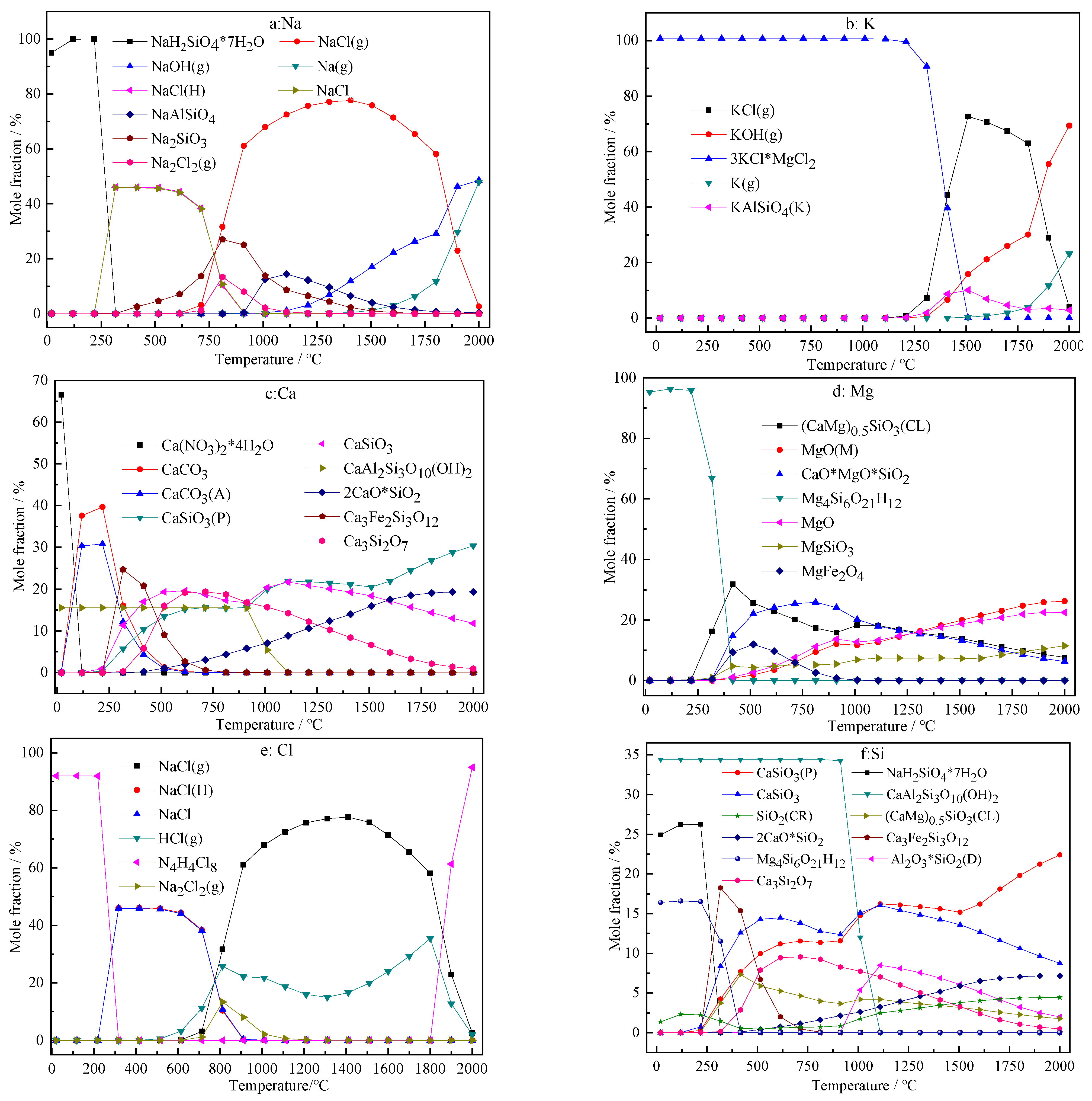
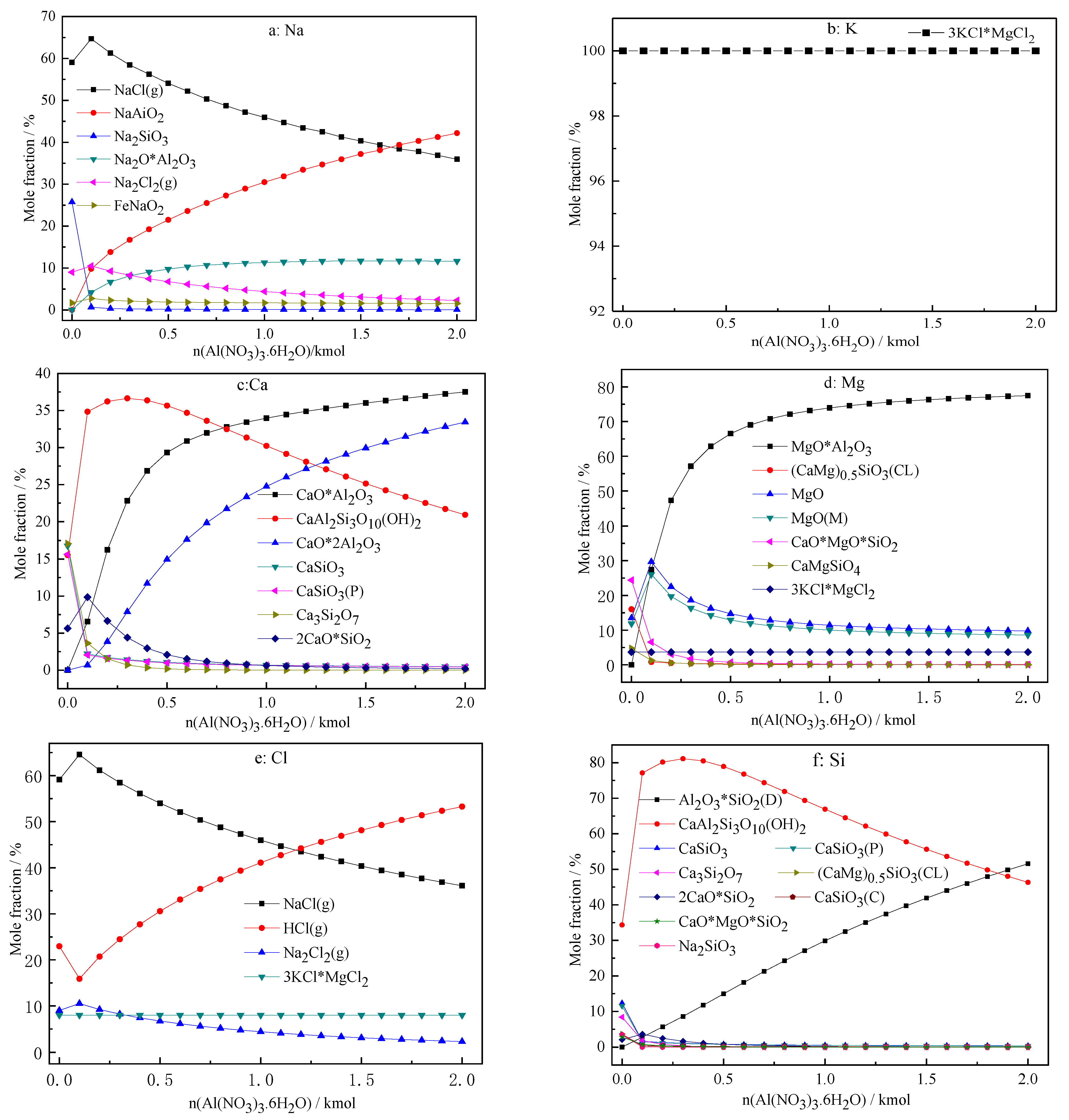
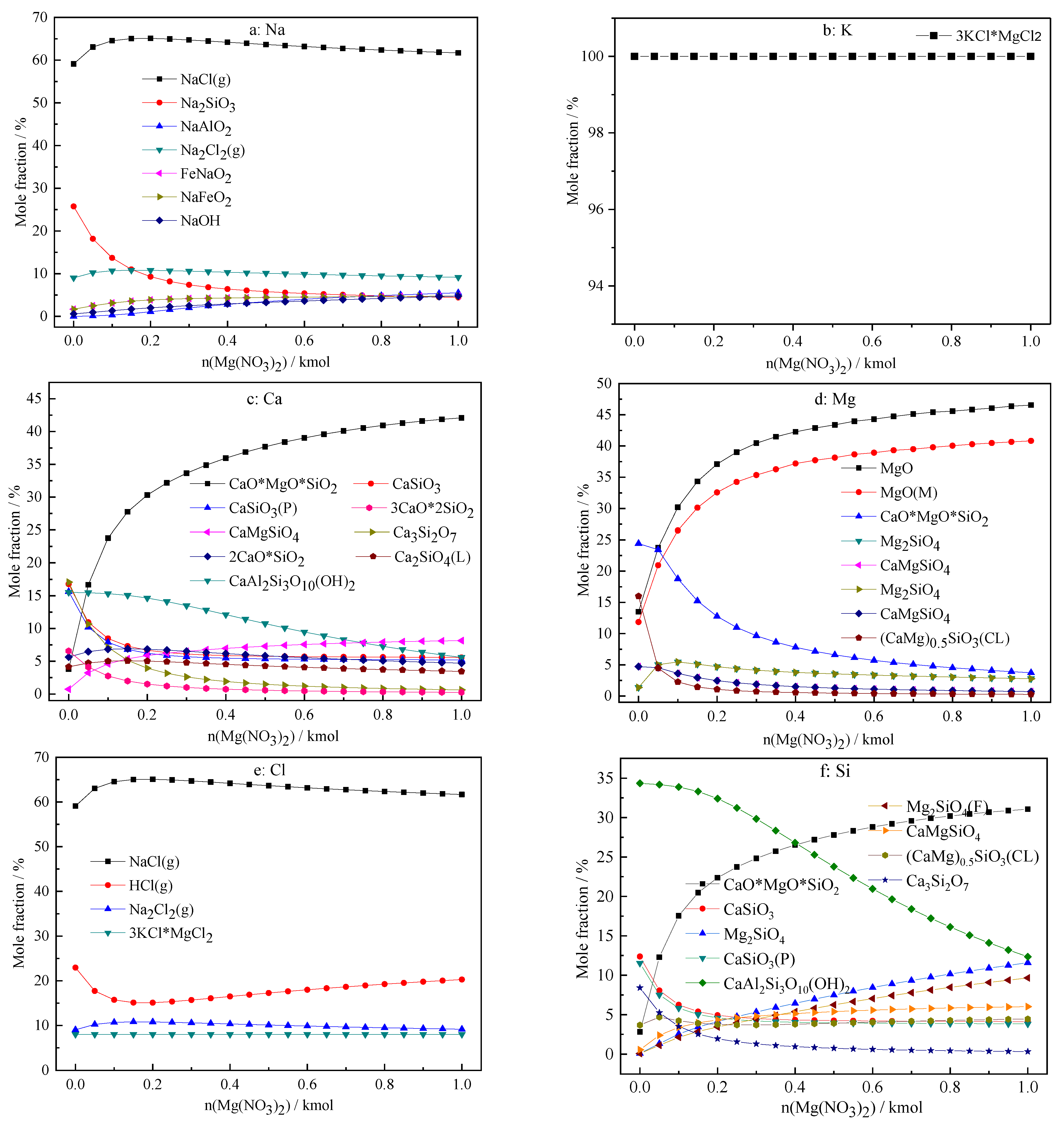
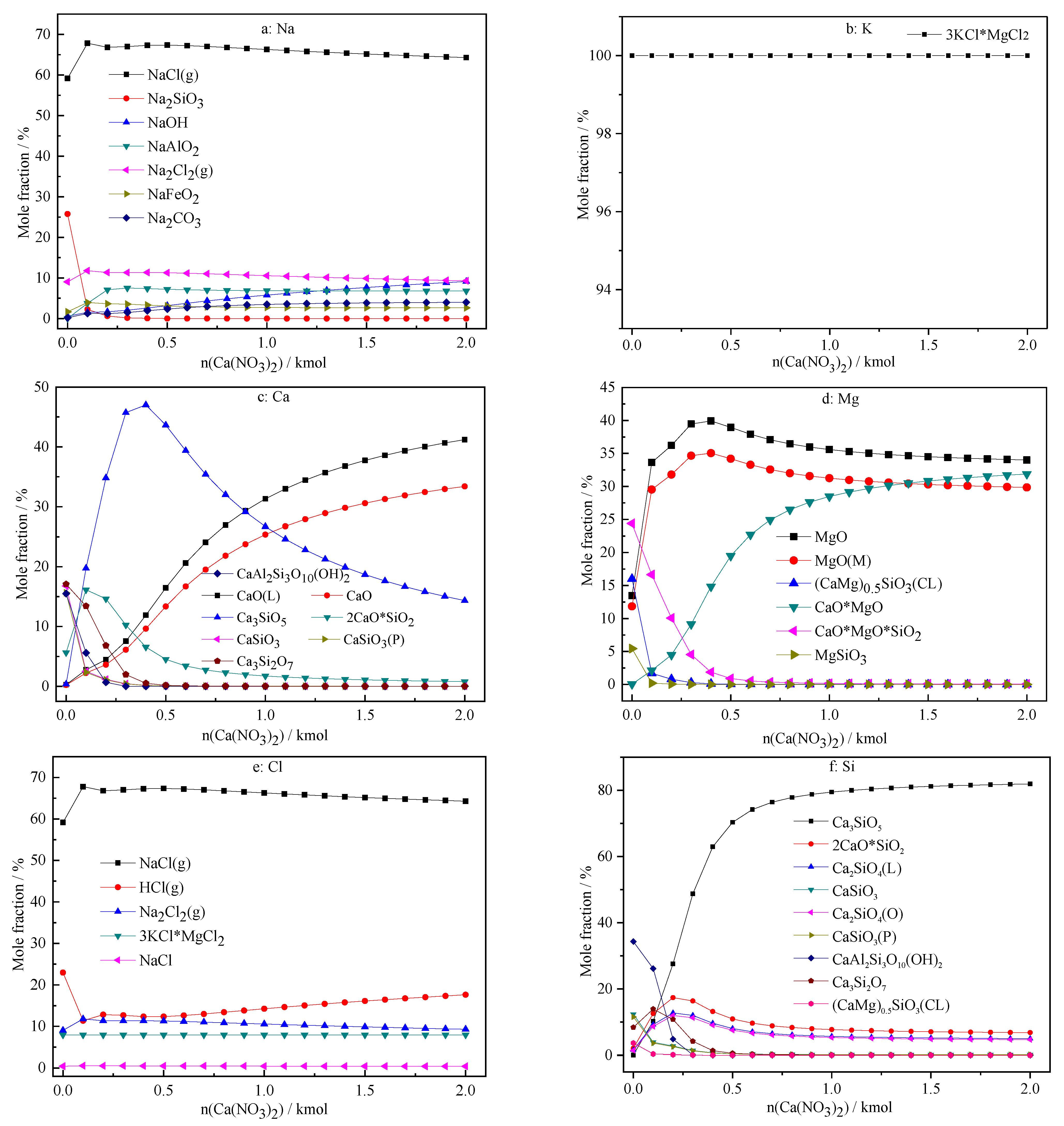
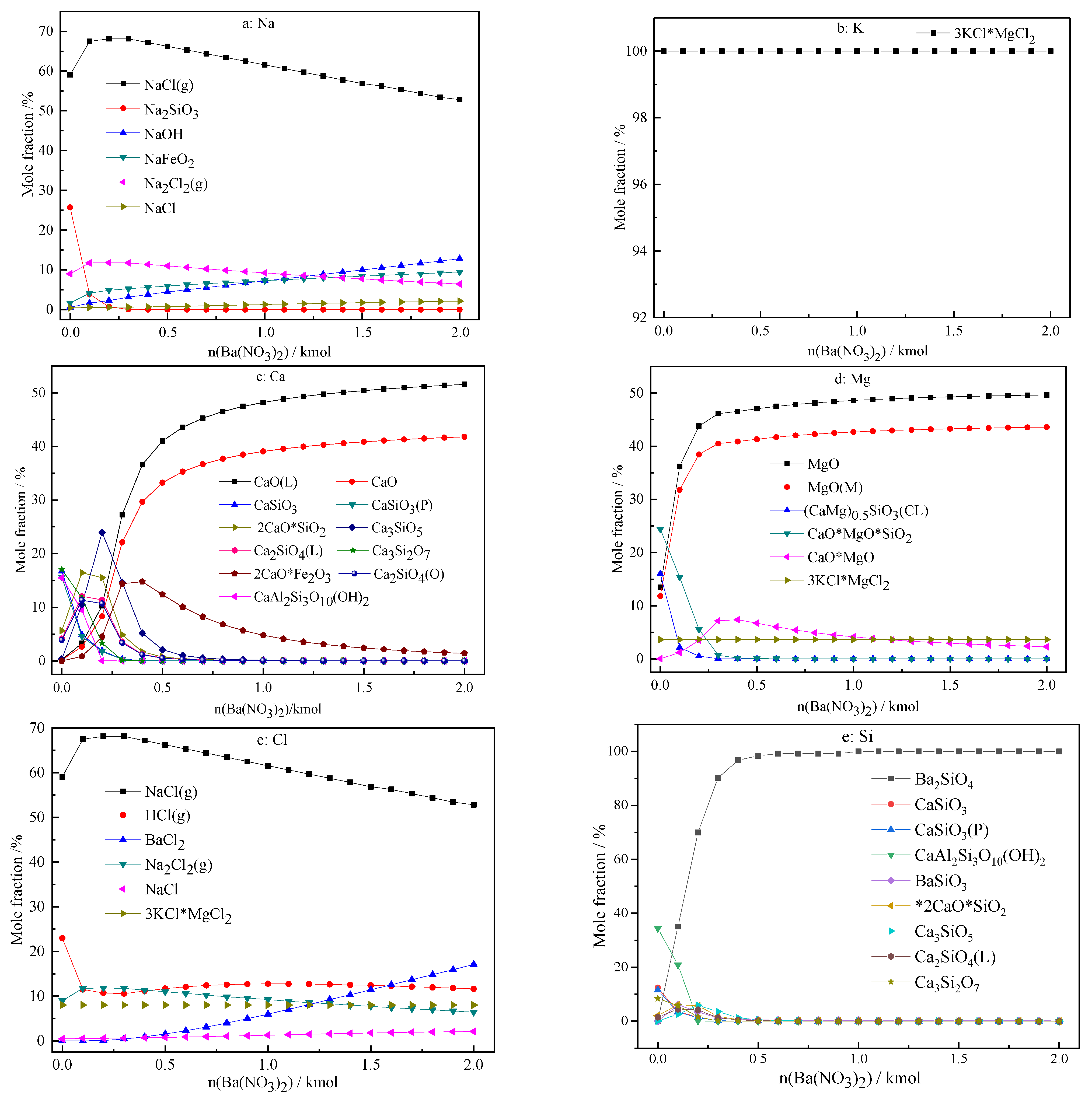

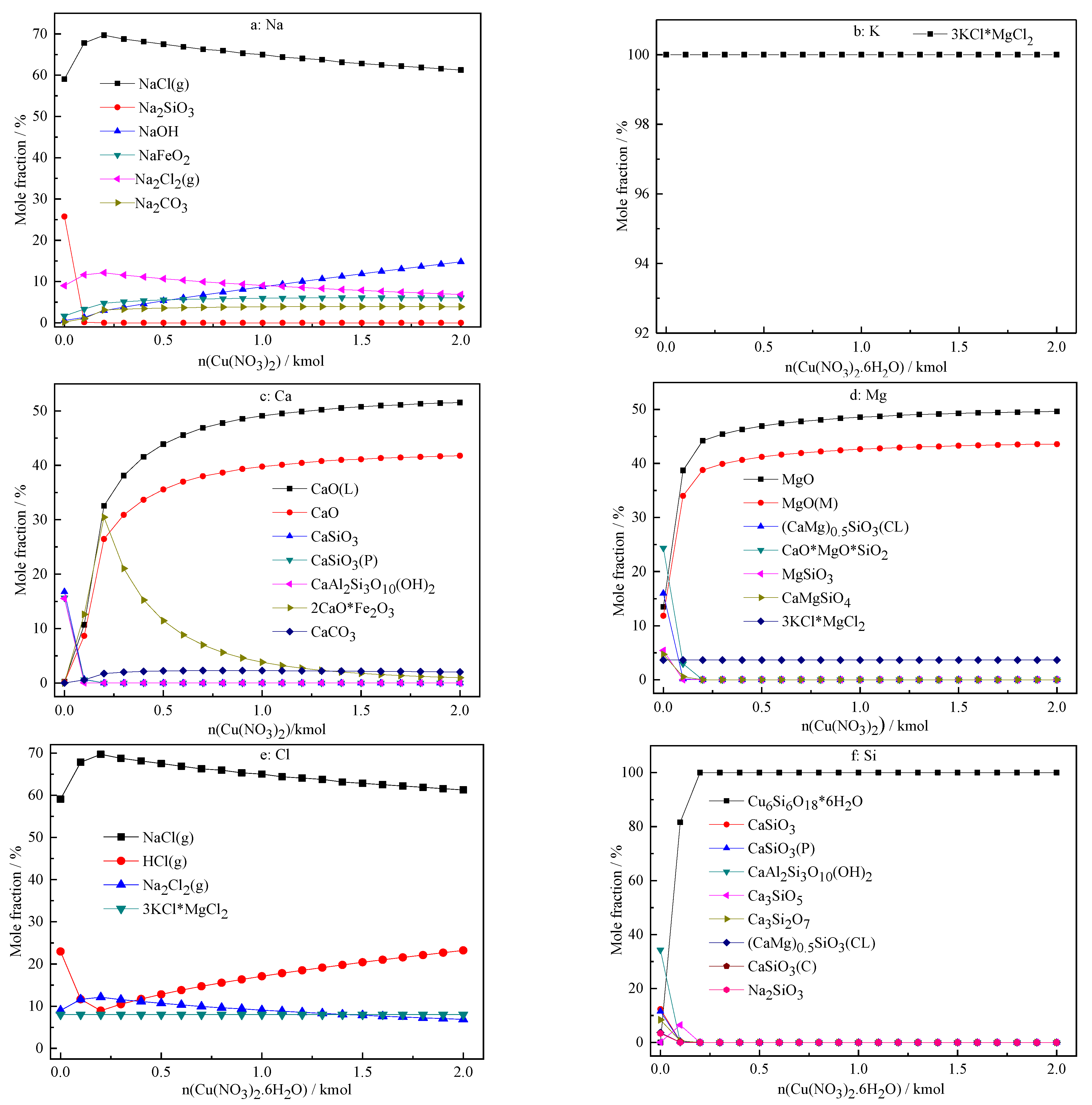

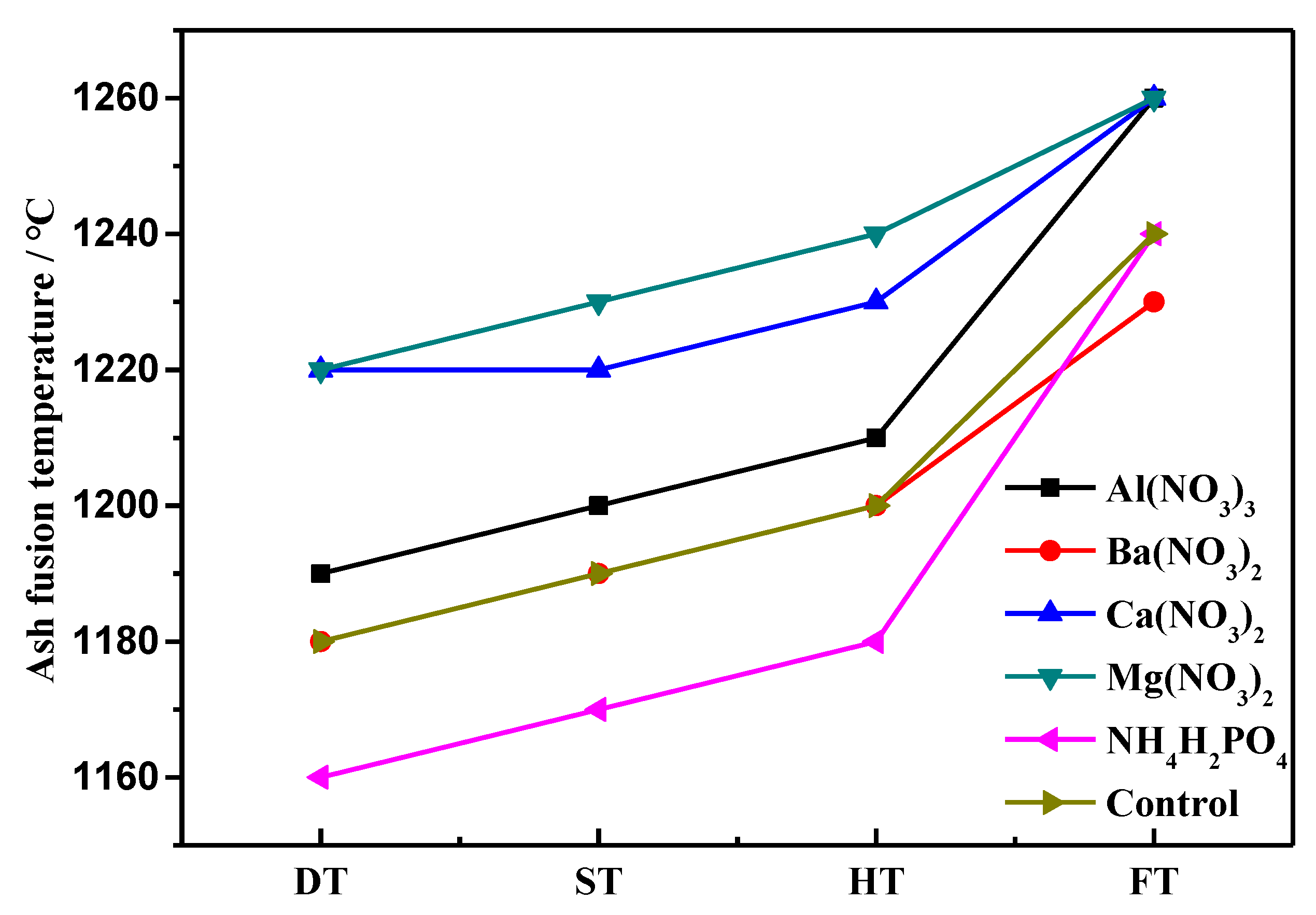
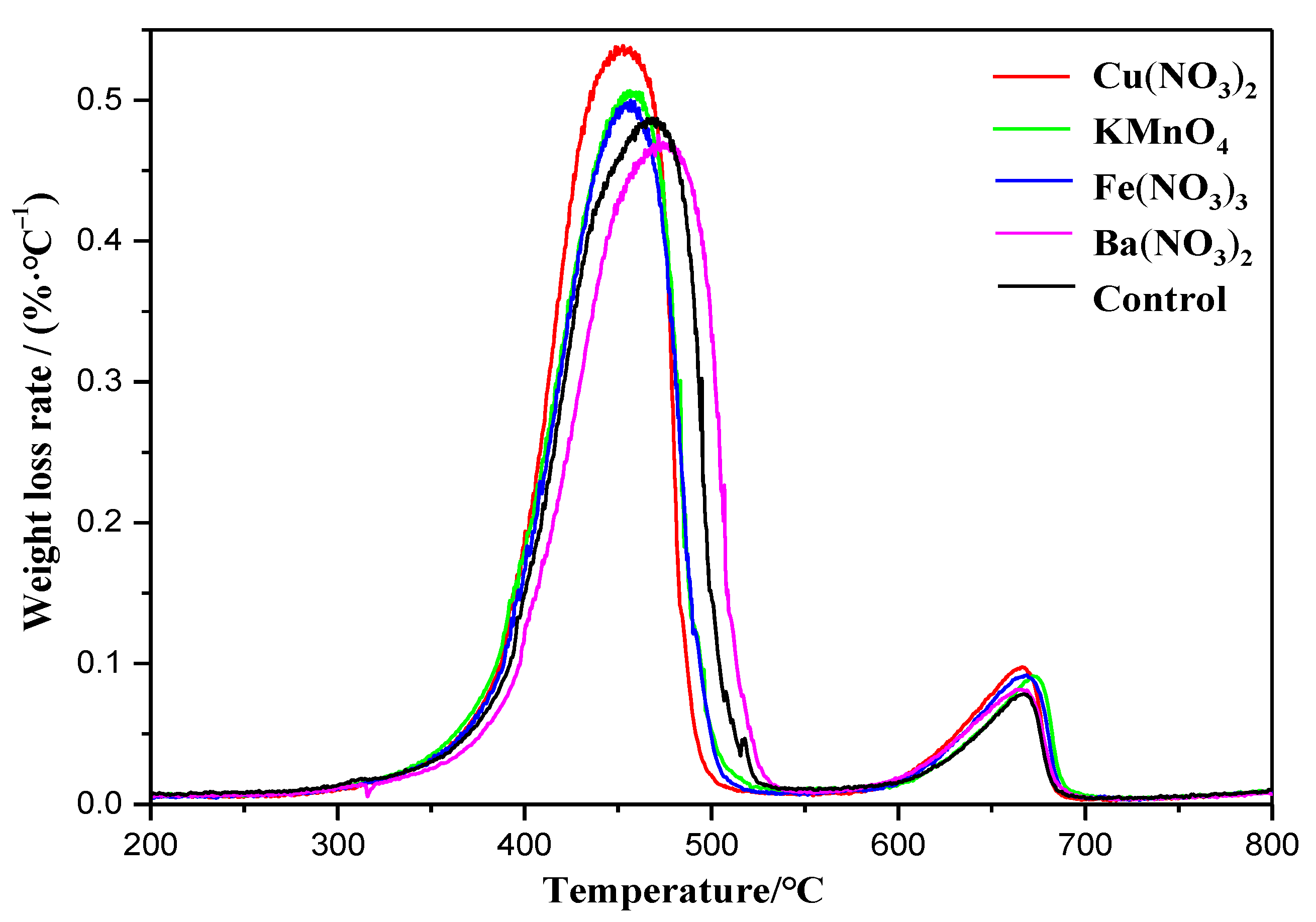
| Element | C | H | O | N | S | Ash |
|---|---|---|---|---|---|---|
| Content/% | 44.43 | 6.71 | 25.47 | 0.79 | 0.14 | 22.45 |
| Compound | Fe2O3 | SiO2 | CaO | Al2O3 | Na2O | MgO | K2O | Cl | SO3 |
|---|---|---|---|---|---|---|---|---|---|
| Content/% | 30.83 | 29.48 | 20.30 | 5.74 | 4.03 | 2.27 | 0.29 | 4.56 | 1.51 |
| Component | Paper | Plastic | Leather Rubber | Cloth | Wood and Grass | Kitchen Waste | Foam |
|---|---|---|---|---|---|---|---|
| Content/% | 12.27 | 26.38 | 5.23 | 12.37 | 2.88 | 39 | 1.87 |
| Additives | Added Amount | Combustion Reactivity | ||
|---|---|---|---|---|
| Ignition Temperature/°C | Temperature at Maximum Weight Loss Rate/°C | Maximum Weight Loss Rate/(% °C−1) | ||
| Cu(NO3)2 | 1% | 399.0 | 452.7 | 0.54 |
| KMnO4 | 1% | 399.8 | 459.7 | 0.51 |
| Ba(NO3)2 | 1% | 410.5 | 471.9 | 0.48 |
| Fe(NO3)3 | 1% | 401.4 | 454.5 | 0.50 |
| Control | - | 403.2 | 468.1 | 0.49 |
Publisher’s Note: MDPI stays neutral with regard to jurisdictional claims in published maps and institutional affiliations. |
© 2022 by the authors. Licensee MDPI, Basel, Switzerland. This article is an open access article distributed under the terms and conditions of the Creative Commons Attribution (CC BY) license (https://creativecommons.org/licenses/by/4.0/).
Share and Cite
Chen, G.; Kang, S.; Zhao, K.; Zheng, A.; Zhao, Z. Screening of Potential Additives for Alleviating Slagging and Fouling during MSW Incineration: Thermodynamic Analysis and Experimental Evaluation. Atmosphere 2022, 13, 1163. https://doi.org/10.3390/atmos13081163
Chen G, Kang S, Zhao K, Zheng A, Zhao Z. Screening of Potential Additives for Alleviating Slagging and Fouling during MSW Incineration: Thermodynamic Analysis and Experimental Evaluation. Atmosphere. 2022; 13(8):1163. https://doi.org/10.3390/atmos13081163
Chicago/Turabian StyleChen, Gang, Shunshun Kang, Kun Zhao, Anqing Zheng, and Zengli Zhao. 2022. "Screening of Potential Additives for Alleviating Slagging and Fouling during MSW Incineration: Thermodynamic Analysis and Experimental Evaluation" Atmosphere 13, no. 8: 1163. https://doi.org/10.3390/atmos13081163
APA StyleChen, G., Kang, S., Zhao, K., Zheng, A., & Zhao, Z. (2022). Screening of Potential Additives for Alleviating Slagging and Fouling during MSW Incineration: Thermodynamic Analysis and Experimental Evaluation. Atmosphere, 13(8), 1163. https://doi.org/10.3390/atmos13081163







